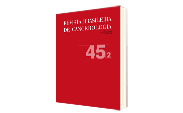Neoplasia Endócrína Múltipla tipo 2b - Relato de três casos e revisão de Literatura
DOI:
https://doi.org/10.32635/2176-9745.RBC.1999v45n2.2776Palabras clave:
Carcinoma Medular de Tireóide, Feocromocitoma, Neoplasia Endócrina MúltiplaResumen
Neoplasia Endocrina Múltipla tipo 2B (NEM-2B) é uma síndrome incomum, herdada de forma autossômica dominante e com penetrância variável. Múltiplos órgãos são envolvidos, mas com uma tríade predominante de carcinoma medular de tireóide, feocromocitoma e ganglioneuromas do trato gastrointestinal. A maioria dos pacientes tem fácies característica, composta por eversão e alargamento dos lábios e eversão das pálpebras por neuromas mucosos. Os autores relatam três casos de NEM-2B, sendo dois do sexo masculino, com idade média de 15,9 anos. A manifestação clínica inicial em todos os casos foi crescimento de massa cervical em topografia de tireóide e hábito marfanóide. Foram submetidos a tireoidectomia total, com esvaziamento cervical bilateral por carcinoma medular de tireóide. Um paciente apresentou feocromocitoma quatro anos após o diagnóstico de tumor de tireóide, sendo submetido a laparotomia com excisão do tumor. Um paciente evoluiu a óbito 2,5 anos após o diagnóstico e os outros dois encontram-se livres de doença, com uma média de acompanhamento ambulatorial de um ano, apesar do teste de calcitonina positivo em um dos casos.
Descargas
Citas
RAUE, F.; FRANK-RAUE, K.; GRAUER, A.- Multiple endocrine neoplasia type 2: Clinicai features and screening. Endocrinol Metab Clin Norlh Am, 1994, 23:137-156. DOI: https://doi.org/10.1016/S0889-8529(18)30121-X
WHITE, M.P.; GOEL, K.M.; CONNOR, J.M.; et al.- Mucosal neuroma syndrome- a phenotype for malignancy. Arch Dis Child, 1985, 60:876-877. DOI: https://doi.org/10.1136/adc.60.9.876
WOHLLK, N.; COTE, G.J.; EVANS, D.B.; et al.- Application of genetic screening information to the anagement of medullary thyroid carcinoma an multiple endocrine neoplasia type 2. Endocrinol Metab Clin NorthAm, 1996,25:1-25. DOI: https://doi.org/10.1016/S0889-8529(05)70310-8
GOUDET, R; ROGISSART, R; PETIT, J.M.; et al.- Facteurs pronostiques de survie des cancers médullaires de la thyroide. Ann Chir, 1996, 50:23-29.
LEDGER, G.A.; KHOSLA, S.; LINDOR, N.M.; et al.- Genetic testing in the diagnosis and management of multiple endocrine neoplasia type 11. Ann íntern Med, 1995, 122:118-124. DOI: https://doi.org/10.7326/0003-4819-122-2-199501150-00008
WELLS, S.A. Jr; BAYLIN, S.B.; GANN, D.S.; et al. - Medullary thyroid carcinoma: relationship of method of diagnosis to pathologic staging. Ann Surg, 1978, 188:377-383. DOI: https://doi.org/10.1097/00000658-197809000-00013
SIPPLE, J.Fl.- The association of pheocromocytoma wiyh carcinoma of the thyroid gland. Am J Med, 1961,31:163-166. DOI: https://doi.org/10.1016/0002-9343(61)90234-0
WILLIAMS, E.D.- A review of 17 cases ofcarcinoma of the thyroid and pheocromocytoma. J Clin Pathol, 1965, 18:288-292. DOI: https://doi.org/10.1136/jcp.18.3.288
STEINER, A.L.; GOODMAN, A.D.; POWERS, S.R.- Study of a kindred with pheocromocytoma, medullarythyroid carcinoma, hyperparathyroidism and Cushing’s disease: multiple endocrine neoplasia, type 2. Medicine, 1968, 47:371-408. DOI: https://doi.org/10.1097/00005792-196809000-00001
O’RIORDANl, D.S.; 0’BRIEN, T.; CROTTY, T.B.; et al.- Multiple endocrine neoplasia type 2B: More than an endocrine disorder. Surgery, 1995, 118:936-942. DOI: https://doi.org/10.1016/S0039-6060(05)80097-2
TROYE, L.; KARNAILLE, B.; KUIEVREUX, J.L.; et al. - Late outcome 302 consecutive patients with multiple gland enlargement in primary hyparatyreoidism treated by conservative surgery. Word J Surg, 1998, 22:526-529. DOI: https://doi.org/10.1007/s002689900430
UTIGER, R.D. - Medullary thyroid carcinoma, genes and the prevention of câncer. New EngJMed, 1994,331:870-871. DOI: https://doi.org/10.1056/NEJM199409293311309
NORTON, J.A.; FROOME, L.C.; FARRELL, R.E.; et al.- Multiple endocrine neoplasia type IIB: The most agressive form of medullary thyroid carcinoma. Surg Clin NorthAm, 1979,59:109-118. DOI: https://doi.org/10.1016/S0039-6109(16)41737-8
O’RIORDANI, D.S.; O’BRIEN, T.; WEAVER, A.L.; et al.- Medullary thyroid carcinoma in multiple endocrine neoplasia types 2A and 2B. Surgery, 1994, 116:1017-1023.
VASEN, H.F.A.; VAN DER FELTZ, M.; RAUE, F.; et al.- The natural course of multiple endocrine neoplasia type lib: A study of 18 cases. Arch Intern Med, 1992, 152:1250-1252. DOI: https://doi.org/10.1001/archinte.152.6.1250
PONDER, B.A. - Medullary carcinoma of the thyroid. In: Peckhann M, Pinedo H, Veronesi U. Oxford Textbook of Oncology. New York: Oxford Medicai Publications, 1995,2110-2122.
MODIGLIANI, E.; VASEN, H.M.; RAUE, K.; et al.- Pheocromocytoma in multiple endocrine neoplasia type 2: European study. J Intern Med, 1995,238:363-367. DOI: https://doi.org/10.1111/j.1365-2796.1995.tb01211.x
LEE, J.E.; CURLEY, S.A.; GAGEL, R.F.; et al. - Cortical-sparing adrenalectomy for patients with bilateral pheochromocytoma. Surgery, 1996, 120:1064. DOI: https://doi.org/10.1016/S0039-6060(96)80056-0
GAGNER, M.; BRETON, G.; PHARAND, D.; et al. - IS laparoscopic adrenalectomy indicated for pheochromocytomas? Surgery, 1996, 120:1076. DOI: https://doi.org/10.1016/S0039-6060(96)80058-4
GRIFFITHS, A.M.; MACK, D.R.; BYARD, R.W.; et al.- Multiple endocrine neoplasia type lib: An unusual cause of chronic constipation. J Ped, 1995, 116:285-288. DOI: https://doi.org/10.1016/S0022-3476(05)82894-X
CARNEY, J.A.; GO, V.L.W.; SIZEMORE, G.W; et al.- Alimentary tract ganglioneuromatosis: A major componente of the syndrome ofmultiple endocrine neoplasia type 2b. New Eng J Med, 1976, 295:1287-1291. DOI: https://doi.org/10.1056/NEJM197612022952304
CLARK, O.H. What’s new in endocrine surgery. J Am Coll Surg, 1997, 184:126.
PACINI, F.; ROMEl, C.; MlCCOLl, R; et al.- Early treatment of hereditary medullary thyroid carcinoma after attribution of multiple endocrine neoplasia type 2 gene carrier status by screening for ret gene mutations. Surgery, 1995, 118:1031-1035. DOI: https://doi.org/10.1016/S0039-6060(05)80110-2
DON1S-KELLER, H.- The ret proto-oncogene and câncer. J Intern Med, 1995, 238:319-25. DOI: https://doi.org/10.1111/j.1365-2796.1995.tb01205.x
MULLIGAN, L.M.; MARSH, D.J.; ROBINSON, B.G.; et al.- Genotype-phenotype correlation in multiple endocrine neoplasia type 2: report of the international ret mutation consortium. J. Intern Med, 1995,238:343-346. DOI: https://doi.org/10.1111/j.1365-2796.1995.tb01208.x
ANDERSON, R.J.; LYNCH, H.T.- Familial neuroendocrine tumors as a model of hereditary câncer. Curr Opin Oncol, 1997, 9:45-54. DOI: https://doi.org/10.1097/00001622-199701000-00008
VELCHIK, M.G.; ALAVl, A.; KRESSEL, H.Y.; et al. – Localization ofpheocromocytoma: MIBG, CT and MRI correlation. J Nucl Med, 1989, 30: 328-333.
SCOPSI, L.; SAMPIETRO, BORACCHl, R; et al.- Multivariate analysis of prognostic factors in sporadic medullary carcinoma of the thyroid: a retrospective study of 109 consecutive patients. Câncer, 1996, 78:2173-2183. DOI: https://doi.org/10.1002/(SICI)1097-0142(19961115)78:10<2173::AID-CNCR20>3.0.CO;2-V










